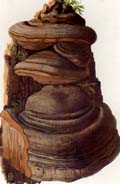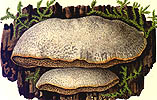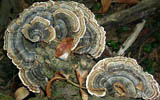 Key to Gilled Mushrooms Key
Key to Gilled Mushrooms KeyThis is a key to gilled mushrooms, that is, mushrooms having a definite cap with a fertile surface consisting of gills. The fruiting body usually also has a stem, although that may be lateral or absent (usually, then, the mushroom is growing from wood). You can use this key to identify mushrooms that you find.
 Polyporaceae Family
Polyporaceae FamilyFertile surface usually a layer of vertical tubes, of which the mouths are visible as pores on the underside of the cap or shelf.
Fruiting bodies usually tougher or harder than the "normal" gilled mushrooms, being leathery, corky, or woody. But they can be quite tender while actively growing
Once grown, they do not decay easily, remaining on the substrate for months or years
They often grow on wood, although a few are terrestrial (even those are usually growing on buried wood)
Fruiting body is usually a flat shelf, or hoof-shaped, protruding directly from the substrate, although sometimes it may have a short stalk.
Some forms never grow away from the substrate at all, so that all that is visible of the fruiting body are the pores.
Sometimes the pores are so minute that the fertile surface seems solid, until you look closely
 Lignicopolypore Subfamily
Lignicopolypore SubfamilyGrowing on wood
Sessiloporus TribeNot fitting the other choices, not stipitate
In making choices below based on texture and size, place the emphasis on texture: if left alone, some of the smaller ones can eventually get quite big; and even the huge ones have to start out small at first
 Small Sessilopolypore Subtribe
Small Sessilopolypore SubtribeIndividual caps small (max. 2-3" across)
Soft or tough, but not hard when fresh, although they may become hard when they dry out
All thin-fleshed fruiting bodies go here, especially if compound or imbricate
 Small Imbricate Polypore SemiTribe
Small Imbricate Polypore SemiTribeFruiting in dense clusters of thin-fleshed shelving fruiting bodies
 Trametes Genus
Trametes GenusCap surface usually furry
Cap either thin, tough and zonate; or whitish, thick and corky
Trimitic hyphae, yet fruiting body not hard
Spores inamyloid, cylindrical
Non-duplex Trametes Section
Diagnosis
- Entire fruiting body white to cream, including flesh; corky
-
Individual caps up to 14" wide, but more often 6-8"; up to 1" thick
Narrow down your identification:
Trametes conchiferThin-fleshed cap (1-4" across) usually forms irregular cups with a bulls-eye pattern on them
Later, sexual fruiting bodies form as small (up to 1" across) thin-fleshed (up to 3 mm) shelves, cap white to tan, zonate, tubes concolorous, 2-4 per mm
 Trametes elegans
Trametes elegansFruiting body shelf-like, or with a short (up to 1") stipe; up to 14" across, 1" thick, white or whitish; corky and flexible when fresh; very finely hairy at first, soon bald or roughened in zones.
Hymenophore usually partially gills, partially pores, changing quickly from one to the other
 Trametes suaveolens
Trametes suaveolensPleasant anise odor when fresh
Entire fruiting body cream to pale tan; up to 6" across
Flesh thin: up to 3.5 mm thick; but tubes up to 1 cm long
Cap finely tomentose or bald, not zonate; margin blunt






 Key to Gilled Mushrooms Key
Key to Gilled Mushrooms Key Polyporaceae Family
Polyporaceae Family Small Sessilopolypore Subtribe
Small Sessilopolypore Subtribe Trametes Genus
Trametes Genus Trametes elegans
Trametes elegans Trametes suaveolens
Trametes suaveolens




